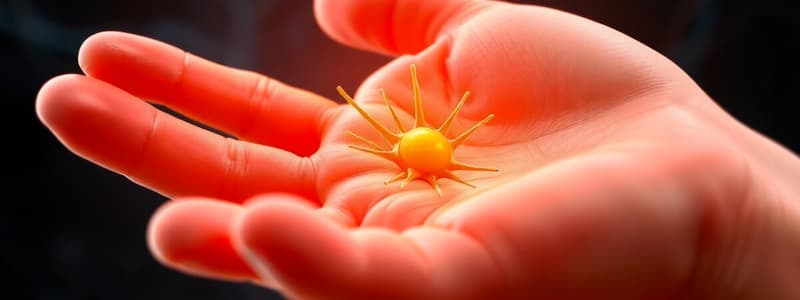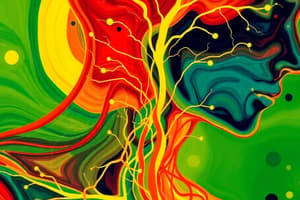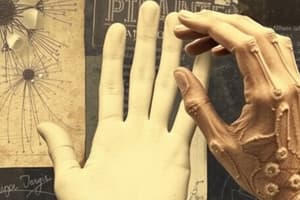Podcast
Questions and Answers
What type of stimulation do SA afferents identify?
What type of stimulation do SA afferents identify?
- Blowing across the skin
- Sustained (correct)
- On/off
- Fluttering
Which of the following is a characteristic of rapidly adapting (FA) afferents?
Which of the following is a characteristic of rapidly adapting (FA) afferents?
- Response to on/off stimulus (correct)
- Response to skin stretch
- Sustained response to continuous stimulus
- Response to sustained pressure
In what skin layer are Merkel cells (SA1) located?
In what skin layer are Merkel cells (SA1) located?
- Subcutaneous layer
- Hypodermis
- Dermis
- Epidermis (correct)
What do PIEZO2 channels in Merkel cells respond to?
What do PIEZO2 channels in Merkel cells respond to?
What type of detection are Merkel cells most important for?
What type of detection are Merkel cells most important for?
What firing pattern is characteristic of SA1 (Merkel cells)?
What firing pattern is characteristic of SA1 (Merkel cells)?
SA1 (Merkel cells) are sensitive to stimulations within what frequency range?
SA1 (Merkel cells) are sensitive to stimulations within what frequency range?
Where are Ruffini organs (SA2) located?
Where are Ruffini organs (SA2) located?
What type of receptive fields do Ruffini organs have?
What type of receptive fields do Ruffini organs have?
What type of indentation threshold do Ruffini organs have?
What type of indentation threshold do Ruffini organs have?
What firing pattern is characteristic of SA2 (Ruffini organs)?
What firing pattern is characteristic of SA2 (Ruffini organs)?
Where are Meissner corpuscles (FA1) located?
Where are Meissner corpuscles (FA1) located?
What do Meissner corpuscles respond to?
What do Meissner corpuscles respond to?
What type of responses do Meissner corpuscles exhibit?
What type of responses do Meissner corpuscles exhibit?
Where are Pacinian corpuscles (FA2) located?
Where are Pacinian corpuscles (FA2) located?
What is the structure of Pacinian corpuscles like?
What is the structure of Pacinian corpuscles like?
Pacinian corpuscles respond to what type of frequencies?
Pacinian corpuscles respond to what type of frequencies?
Which type of stimulus activates Pacinian corpuscles?
Which type of stimulus activates Pacinian corpuscles?
What cortical allocation is related to tactile receptor densities?
What cortical allocation is related to tactile receptor densities?
Approximately ho wmany afferents innervate the hand palm?
Approximately ho wmany afferents innervate the hand palm?
Which receptors most closely resemble braille for texture encoding?
Which receptors most closely resemble braille for texture encoding?
During lifting, which receptor type shows an early response?
During lifting, which receptor type shows an early response?
Which fiber group are the Meissner corpuscles associated with?
Which fiber group are the Meissner corpuscles associated with?
Which of the following describes how receptive field size affects touch sensitivity?
Which of the following describes how receptive field size affects touch sensitivity?
What does a smaller probe area lead to in terms of discharge rates?
What does a smaller probe area lead to in terms of discharge rates?
What is the texture encoding?
What is the texture encoding?
What does high innervation density typically lead to?
What does high innervation density typically lead to?
If a receptive field is large and two points stimulate the same receptor, how are they felt?
If a receptive field is large and two points stimulate the same receptor, how are they felt?
What is the function of the Piezo2 channel?
What is the function of the Piezo2 channel?
Which type of mechanoreceptor is best suited for detecting edges?
Which type of mechanoreceptor is best suited for detecting edges?
Which receptor identifies sustained stimulation?
Which receptor identifies sustained stimulation?
What sensation is the Ruffini ending responsible for?
What sensation is the Ruffini ending responsible for?
What sensation is the Pacinian corpuscle responsible for?
What sensation is the Pacinian corpuscle responsible for?
What sensation is the Merkel disk receptor responsible for?
What sensation is the Merkel disk receptor responsible for?
What sensation is the Meissner corpuscle responsible for?
What sensation is the Meissner corpuscle responsible for?
Flashcards
Microneurography
Microneurography
A technique used to identify the firing of single afferent fibers in response to various stimuli.
FA Afferents
FA Afferents
Rapidly adapting (RA) fibers that respond briefly to the onset and offset of a stimulus. Important for detecting slips and flutters on the skin.
SA Afferents
SA Afferents
Slowly adapting (SA) fibers that respond continuously to sustained stimulation and skin stretch.
Cutaneous mechanoreceptors
Cutaneous mechanoreceptors
Signup and view all the flashcards
Merkel cells (SA1)
Merkel cells (SA1)
Signup and view all the flashcards
Ruffini endings (SA2)
Ruffini endings (SA2)
Signup and view all the flashcards
Meissner corpuscles (FA1)
Meissner corpuscles (FA1)
Signup and view all the flashcards
Pacinian corpuscles (FA2)
Pacinian corpuscles (FA2)
Signup and view all the flashcards
Texture encoding
Texture encoding
Signup and view all the flashcards
Hand coding
Hand coding
Signup and view all the flashcards
Two-point Discrimination
Two-point Discrimination
Signup and view all the flashcards
Receptive field size
Receptive field size
Signup and view all the flashcards
Receptor density
Receptor density
Signup and view all the flashcards
Convergence
Convergence
Signup and view all the flashcards
Study Notes
Overview of Lecture Topics
- Touch receptor morphologies, tactile encoding, tactile sensitivity, and tactile perception are explored
Microneurography and FA Afferents
- Microneurography can identify quickly adapting (FA) afferents
- FA afferents respond to on/off stimuli, slips, flutters, and blowing across the skin
- FAs do not respond to sustained stimulation
Microneurography and SA Afferents
- Microneurography can identify slowly adapting (SA) afferents
- SA afferents respond to sustained stimulation and stretch (SA2)
Cutaneous Receptor Morphology
- There are 4 types of cutaneous receptors
Mechanoreceptor Morphologies: SA1 (Merkel Cells)
- SA1 mechanoreceptors are located within the epidermis, specifically at fingerprint ridges.
- PIEZO2 channels are critical for skin deformation response.
- Deleting PIEZO2 reduces response to static indentation in studies using mouse models
- Merkel cells encode pressure
- Vesicles release norepinephrine
- Detect points, edges, and curvature
- SA1 mechanoreceptors crucial for shape detection
Firing Characteristics: SA1 (Merkel Cells)
- SA1 Merkel cells exhibit fundamental responses to sustained indentation due to norepinephrine release from vesicles.
- Firing pattern is irregular
- Sensitive to points, edges and shapes
- Sensitive to low frequency vibrations (2-32Hz)
Mechanoreceptor Morphologies: SA2 (Ruffini Organs)
- SA2 mechanoreceptors have a spindle shape.
- Located in the dermis, tendons, and ligaments.
- 1 afferent innervates each Ruffini organ.
- These have diffuse receptive fields.
Firing Characteristics: SA2 (Ruffini Organs)
- SA2 Ruffini organs have a high threshold for indentation and a regular firing pattern.
- Sensitive to skin stretch and force
- Responds to skin deformation without direct pressure
- SA2s continue to respond even after a stimulus is removed and the skin remains deformed.
- Sensitive to low vibration frequencies (<8Hz).
Mechanoreceptor Morphologies: FA1 (Meissner Corpuscles, RAs)
- FA1 receptors are located withing dermal papillae, close to the skin cells
- Elongated receptors containing flattened lamella cells
- They express PIEZO2 channels
- 1 afferent terminates in 2-6 corpuscles
- Movement of ridges and valleys activates receptors
Response Characteristics: FA1 (Meissner Corpuscles, RAs)
- FA1 receptors show distinct on-off responses and respond to flutters.
- Codes rate and shear velocity of skin indentation
- Respond to slip and tangential forces
- Useful for grip control and sensitive to edges.
- Respond to low-mid frequencies (8-64Hz).
Mechanoreceptor Morphologies: FA2 (Pacinian Corpuscles, PCs)
- FA2 mechanoreceptors are located deep in the dermis.
- Onion-like structures with multiple layers of membranes.
- Act as a filter for low frequencies
- Innervated by only 1 afferent fiber and respond to high frequencies
Response Characteristics: FA2 (Pacinian Corpuscles, PCs)
- FA2 Pacinian corpuscles show distinct on-off responses and are activated by blowing across the skin
- Code acceleration and vibrations
- Respond to high frequencies. (>64Hz, favor 250Hz)
Responses During Lifting
- Multiple receptors are engaged during lifting, from initial contact to release.
- SA2 receptors do not require as much force
Perception Modalities
- Cutaneous and subcutaneous mechanoreceptors: Alpha-beta Fibers
- Meissner corpuscle: RA1 for stroking/flutter
- Merkel disk receptor: SA1 for pressure/texture
- Pacinian corpuscle: RA2 for vibration
- Ruffini ending: SA2 for skin stretch
Texture Encoding
- The size and shape of objects touching the hand can be coded for by SAI's
- A smaller probe area results in higher discharge rates in fewer receptors
- A larger probe results in lower discharge rates, but engages more afferents.
Texture Encoding and Receptor Resolution
- SA1s most closely resemble braille since they have a very high spacial resolution
- FA1s present a blurred image because RFs are slightly larger than the spacing
- SA2 and FA2 do not capture the pattern at all because RFs are too large
Touch Sensitivity: Receptive Field Sizes
- Touch sensitivity varies across regions due to receptive field sizes and innervation density.
- Higher sensitivity is associated with small receptive fields.
- Lower sensitivity is associated with large receptive fields.
Touch Sensitivity: Innervation Density
- More dense innervation leads to more sensitivity
- Less dense innervation leads to less sensitivity
Two-Point Discrimination
- Two-point discrimination depends on receptive field size, convergence, and receptor density
- Higher sensitivity is associated with small receptive fields and greater receptor density
Studying That Suits You
Use AI to generate personalized quizzes and flashcards to suit your learning preferences.




